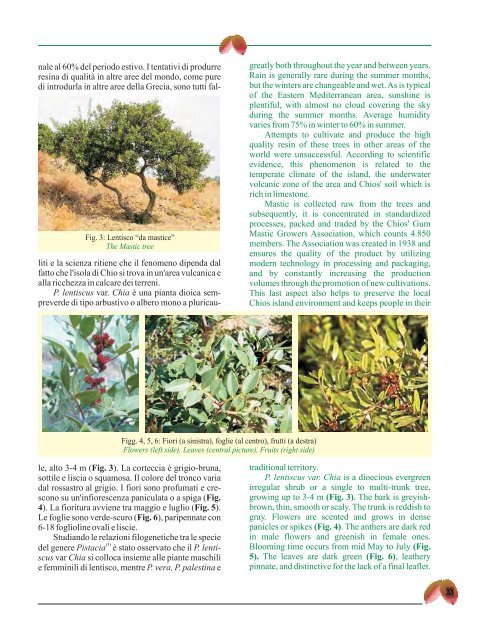Following Pistachio Footprints - Acta Horticulturae
Following Pistachio Footprints - Acta Horticulturae
Following Pistachio Footprints - Acta Horticulturae
Create successful ePaper yourself
Turn your PDF publications into a flip-book with our unique Google optimized e-Paper software.
nale al 60% del periodo estivo. I tentativi di produrre<br />
resina di qualità in altre aree del mondo, come pure<br />
di introdurla in altre aree della Grecia, sono tutti fal-<br />
Fig. 3: Lentisco “da mastice”<br />
The Mastic tree<br />
liti e la scienza ritiene che il fenomeno dipenda dal<br />
fatto che l'isola di Chio si trova in un'area vulcanica e<br />
alla ricchezza in calcare dei terreni.<br />
P. lentiscus var. Chia è una pianta dioica sempreverde<br />
di tipo arbustivo o albero mono a pluricau-<br />
Figg. 4, 5, 6: Fiori (a sinistra), foglie (al centro), frutti (a destra)<br />
Flowers (left side), Leaves (central picture), Fruits (right side)<br />
le, alto 3-4 m ( Fig. 3).<br />
La corteccia è grigio-bruna,<br />
sottile e liscia o squamosa. Il colore del tronco varia<br />
dal rossastro al grigio. I fiori sono profumati e crescono<br />
su un'infiorescenza paniculata o a spiga ( Fig.<br />
4). La fioritura avviene tra maggio e luglio ( Fig. 5).<br />
Le foglie sono verde-scuro ( Fig. 6),<br />
paripennate con<br />
6-18 foglioline ovali e liscie.<br />
Studiando le relazioni filogenetiche tra le specie<br />
(3)<br />
del genere Pistacia è stato osservato che il P. lentiscus<br />
var Chia si colloca insieme alle piante maschili<br />
e femminili di lentisco, mentre P. vera, P. palestina e<br />
greatly both throughout the year and between years.<br />
Rain is generally rare during the summer months,<br />
but the winters are changeable and wet.As is typical<br />
of the Eastern Mediterranean area, sunshine is<br />
plentiful, with almost no cloud covering the sky<br />
during the summer months. Average humidity<br />
varies from 75% in winter to 60% in summer.<br />
Attempts to cultivate and produce the high<br />
quality resin of these trees in other areas of the<br />
world were unsuccessful. According to scientific<br />
evidence, this phenomenon is related to the<br />
temperate climate of the island, the underwater<br />
volcanic zone of the area and Chios' soil which is<br />
rich in limestone.<br />
Mastic is collected raw from the trees and<br />
subsequently, it is concentrated in standardized<br />
processes, packed and traded by the Chios' Gum<br />
Mastic Growers Association, which counts 4.850<br />
members. The Association was created in 1938 and<br />
ensures the quality of the product by utilizing<br />
modern technology in processing and packaging,<br />
and by constantly increasing the production<br />
volumes through the promotion of new cultivations.<br />
This last aspect also helps to preserve the local<br />
Chios island environment and keeps people in their<br />
traditional territory.<br />
P. lentiscus var. Chia is a dioecious evergreen<br />
irregular shrub or a single to multi-trunk tree,<br />
growing up to 3-4 m (Fig. 3) . The bark is greyishbrown,<br />
thin, smooth or scaly. The trunk is reddish to<br />
gray. Flowers are scented and grows in dense<br />
panicles or spikes (Fig. 4) . The anthers are dark red<br />
in male flowers and greenish in female ones.<br />
Blooming time occurs from mid May to July (Fig.<br />
5). The leaves are dark green (Fig. 6) , leathery<br />
pinnate, and distinctive for the lack of a final leaflet.<br />
33

















